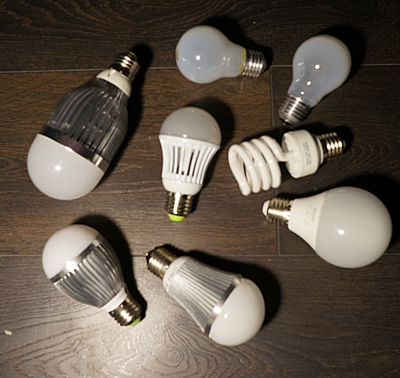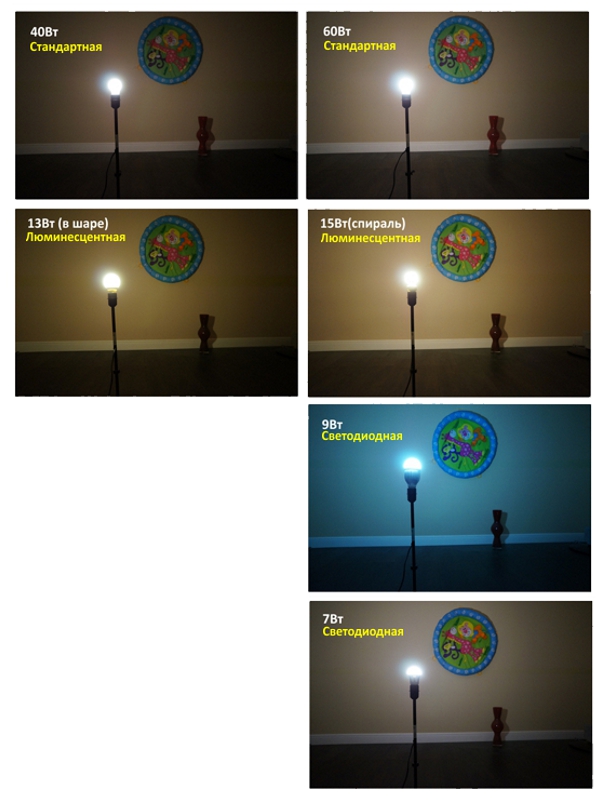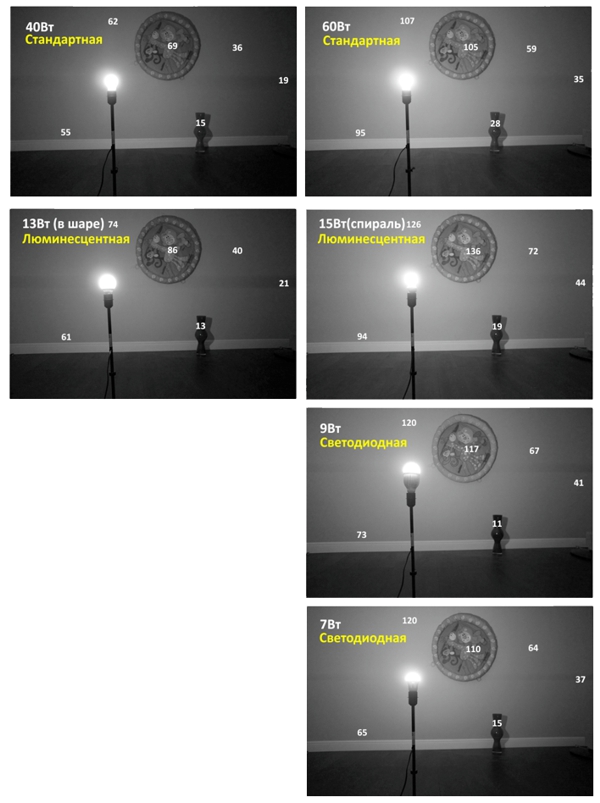LED light bulbs. Practice

Introduction
Like many, I really liked the post about the internal structure of LED bulbs . The only thing missing was to see how all this shines in life. Over the past six months, a dozen Chinese LED bulbs have accumulated and some experience that I want to share.
Update 02/11 23:00 - New test, new bulbs.
Light bulbs
A pair of LED bulbs was chosen as a replacement for the usual 60W (different in price and quality). For comparison, I took a couple of ordinary and fluorescent bulbs:

1) Normal 60W Philips (720Lm / 2700K)
2) Normal 40W Philips (415Lm / 2700K)
3) Luminescent spiral in a ball 13W Navigator (780Lm / 2700K)
4) Luminescent spiral 15W Shine ( 900Lm / 2700K)
5) LED 9W China (cheap) (declared 800Lm / 3000K, turned dimmer and more than 5000K)
6) LED 7W China (expensive) (declared 630Lm / 3015K, subjectively corresponds)
Test
- Room 3x4 meters.
- The lamp is approximately in the center at a height of about 70 cm from the floor.
- Shutter speed, aperture, ISO, white balance of the camera are fixed.

The same thing, but the image was converted from RGB to HLS and taken L (light layer). The numbers indicate the brightness of identical points in the photographs:

results
Of course, modern luminescent is quite a worthy alternative:
+ compact;
+ mercury in a safer “non-liquid” form - the amalgam does not evaporate to 60 degrees;
+ reasonable price (about 150 rubles);
- there are cons, but there are few of them (they turn on for 30-40 seconds, there may be flicker, it’s difficult to dispose of).
But LEDs are not so bad and can become a worthy replacement for conventional and fluorescent lamps, especially those that are more expensive:
+ percent 30% more economical than fluorescent in electricity consumption;
+ turn on immediately;
+ no flicker;
+ no mercury;
+ "warm color" lamps are very close to ordinary incandescent lamps;
- a dispersion angle of 180 degrees (subjectively there is a slight difference, but very little, but it will not be at all in the ceiling lamps);
- price (about 550 rubles for a good lamp with delivery).
About China
If you decide to order an LED lamp in China, it is better not to chase the price to the last, especially if you are not sure about the manufacturer.
Now the margin of the Chinese manufacturing plant with 5-9W e27 light bulbs is 2-4 $ . And this is the margin - with which you still have to pay salaries, maintain the building and equipment, and bear marketing expenses. Therefore, if you see the price much less than the others, then this is a "pig in a poke" and to a greater extent - they either lie with the characteristics or completely unreliable components and the quality and appearance are lame.
Update
A bit of video innards:
General view, build quality, and the LEDs themselves:
Update 02/11 23:00
Video with 6 bulbs: for ease of comparison, the roller is duplicated - select the time on the rollers in accordance with the bulbs
1) 00:00 - 00:23 // 60W Philips incandescent lamp (700Lm / 2700K)
2) 00:24 - 00:48 // 7W LED LongSun (600Lm / 3050K)
3) 00:49 - 01:12 // 8W LED Century (520 Lm / 2500K)
4) 01:13 - 01:38 // 75W lamp filing Philips (900Lm / 2700K)
5) 01:39 - 02:02 // 15W fluorescent Shine (900Lm / 2700K)
6) 02:03 - 02:30 // 9W LED LongSun (800Lm / 3050K)
